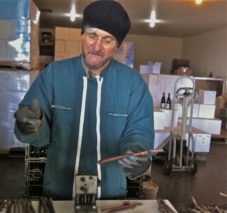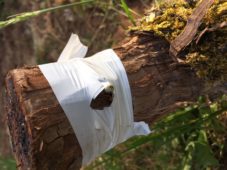Grafting (without the corruption)
From John, February 27th, 2019
John bench grafting

a field grafted Pinot noir vine
Here in winter of 2019, clearly there is a whiff of graft in the air! Though what they define as “graft” in our political arena is quite a different concept from what “graft” means at Cameron Winery. In late February or early March, you can usually find us engaged in our form of graft.
Why graft grape vines?
Most of the world’s wine is made from Vitis vinifera, a species of grape native to Europe and Asia. While it is certainly possible to grow Vitis Vinifera on its own roots, most viticultural regions now have infections of Phylloxera (a pesky little American root louse that literally devours the roots of our beloved vinifera vines). In response to this microarthropod, our friends in France long ago figured out a way to deal with it.
If one grafts a shoot of Vitis vinifera (a “scion) onto rootstock derived from native North American vines (which are resistant to the little louse), “Et voilà, le travail!”, a viable vine results that can grow in the presence of Phylloxera. Of course that’s just the theory. The reality involves a number of different approaches to the subject.
How do we do it?
In Oregon, we commonly “bench graft” winter cuttings from dormant scion and rootstock in order to propogate new vines. It is a bit of an art to line up complimentary scion and rootstock “sticks”, make a cut in one and complimentary cut in the other (think of a positive and a negative) and put them together. After joining the parts, we lay the successive grafted vines in a box of moist perlite and keep them warmed at 70F for approximately 3 weeks. At the end of that time, a healthy callus has knitted the two halves together and we immerse the rootstock in rooting hormone, then in potting soil. The whole “plant” is put in the greenhouse to await budbreak of the scion and growth of roots below from the rootstock. If the resulting vine is healthy, we nurture it throughout the summer and plant it in vineyard the fall.
The second method of grafting is called “chip budding” or “T-budding” and is done on mature vines that already have a healthy root structure. In this case, the growth at the head of a mature vine is cut off and a scion bud is inserted into a cleft or “T” cut into the remaining trunk. The little bud is carefully wrapped by tape wound round and round the trunk until it is secure. In a few weeks the bud will have formed a callus with the rootstock and will begin to grow. This is an excellent method for changing the type of vine that one has in the vineyard. For example, at Cameron many years ago we made the mistake of planting Dijon clones. And now, 20 years later, with healthy root structure resistant to Phylloxera, we are slowly grafting over these vines to old Burgundy clones of both Pinot noir and Chardonnay. We lose one year of productivity but then are back in production with superior grapes!
Share ThisIrrigation: the oxycontin of viticulture
Next Post »Some unexpected effects of climate change
Recent News & Rants
old vines, old wines & an old winemaker
One of the advantages of being an “old-timer” in the world of enology and viticulture is that our vines have aged along with me. It is a well known phenomenon in the world of wine that old vines tend to produce superior wine. A recent tasting of 18 vintages of Clos Electrique Blanc magnums proved that adage to be true! Overall, the consensus was that 8-14 years of aging seems to be the absolute “sweet spot” for this magnificent vineyard.
There’s More... >What do winter cold snaps do to the vineyard?
With climate progressively changing, one phenomena that is starting to occur fairly regularly is an occasional bout of intense winter cold weather. In January 2024, temperatures descended to as low as 4F in high altitude vineyards. Read on to learn how grapevines respond to this stress.
There’s More... >Cheers to a fantastic year ahead!
Bottles of Cameron Winery wine that are currently for sale.
2022 Dundee Hills Chardonnay, 2021 White Oak Pinot noir, 2021 Abbey Ridge Pinot noir, 2021 Clos Electrique Rouge, 2021 Clos Electrique Blanc, 2022 White […]
There’s More... >

